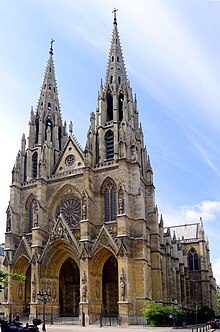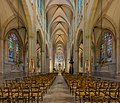Sainte-Clotilde, Paris
This article needs additional citations for verification. (December 2007) |
| Sainte-Clotilde, Paris | |
|---|---|
 The west front of the church | |
 | |
| 48°51′30″N 2°19′09″E / 48.858333°N 2.319167°E | |
| Country | |
| Denomination | Roman Catholic |
| Website | www |
| History | |
| Status | Minor Basilica |
| Architecture | |
| Functional status | Active |
| Heritage designation | Monument historique |
| Style | French Gothic |
| Groundbreaking | 1846 |
| Completed | 1857 |
| Specifications | |
| Number of towers | 2 |
| Tower height | 69 metres (226 ft) |
| Number of spires | 1 |
| Administration | |
| Archdiocese | Paris |
The Basilica of Saint Clotilde (Basilique Ste-Clotilde) is a basilica church in Paris, located on the Rue Las Cases, in the 7th arrondissement. It is best known for its twin spires.
History
Construction of the church was first mooted by the Paris City Council on 16 February 1827. It was designed by architect F. C. Gau of Cologne in a neo-Gothic style. Work began in 1846, but Gau died in 1853, and the job was continued by Théodore Ballu who completed the church in 1857. It was opened on 30 November 1857 by Cardinal Morlot. The church was declared a minor basilica by Pope Leo XIII in 1896.[1]
Architecture
This neo-gothic basilica is marked by its two towers 69 meters high.
The interior is clear and there are stained glass windows by Thibaut (a 19th-century glassmaker), paintings by Jules Eugène Lenepveu, sculptures by James Pradier and Francisque Joseph Duret. A series of sculptures by Jean-Baptiste Claude Eugène Guillaume representing the conversion of Valerie of Limoges, her condemnation to death, decapitation and the appearance of Saint Martial.
The building dominates the Samuel-Rousseau square, where one can see chestnut trees.
The basilica was copied by the architect Léon Vautrin for the construction of the facade of the Sacred Heart Cathedral in Guangzhou between 1863 and 1888.
The Rectors and Vicars of Sainte-Clotilde
Abbot Arthur Mugnier, nicknamed the "confessor of the duchesses," and who left a diary, was one of the vicars.
Abbé Henri Chaumont, vicar of the parish from 1869 to 1874, in 1872 with Caroline Carré de Malberg founded the Society of the Daughters of Saint Francis de Sales, whose mother-house moved to Lorry-lès-Metz.
Abbé Albert Colombel was first vicar in 1914.
Abbé Bernard Bouveresse, a member of the Resistance, was parish priest and rector of Sainte-Clotilde from the post-war period to his death.
In 1993, the rector of Sainte-Clotilde, the abbot Alain Maillard de La Morandais was appointed chaplain of the parliamentarians.
In 1992, Cardinal Jean-Marie Lustiger, Archbishop of Paris, created the Pastoral Service for Political Studies. In 1995, he entrusted the direction to Father Antoine de Vial, who received the Pontifical Prelature in 2001.
From 2005 to 2012, Father Matthieu Rougé held both positions.
In September 2012, Father Laurent Stalla-Bourdillon, former vicar of the church of Saint-Germain-des-Prés, was appointed rector of the Sainte-Clotilde church and director of SPEP.
Organ
St Clotilde is famous for the Aristide Cavaillé-Coll organ (1859, enlarged 1933 and electrified 1962) played by César Franck and the succession of famous composers who have been Organiste titulaire:[2]
- César Franck 1859–1890
- Gabriel Pierné 1890–1898
- Charles Tournemire 1898–1939
- Joseph-Ermend Bonnal 1942–1944
- Jean Langlais 1945–1988
- Pierre Cogen and Jacques Taddei 1987–1993
- Jacques Taddei 1993–2012
- Olivier Penin 2012–
In addition to these titular organists, Théodore Dubois served Sainte-Clotilde as choir organist from 1858 and as choirmaster from 1863 till his appointment as organist at the Madeleine in 1869.[3]
Gallery
-
The pulpit
-
The sanctuary
-
Interior of the church
-
The Sainte-Clotilde as seen from the Eiffel Tower
-
Statue of Saint Clotilde.
See also
- Sacred Heart Cathedral of Guangzhou, the facade of which was based on the Basilica of St. Clotilde
- List of works by James Pradier Stations of the Cross
Notes
- ^ [1]
- ^ History& stoplist
- ^ Pasler, Jann (2001). "Dubois, Théodore". In Sadie, Stanley; Tyrrell, John (eds.). The New Grove Dictionary of Music and Musicians (2nd ed.). London: Macmillan Publishers. ISBN 978-1-56159-239-5.





